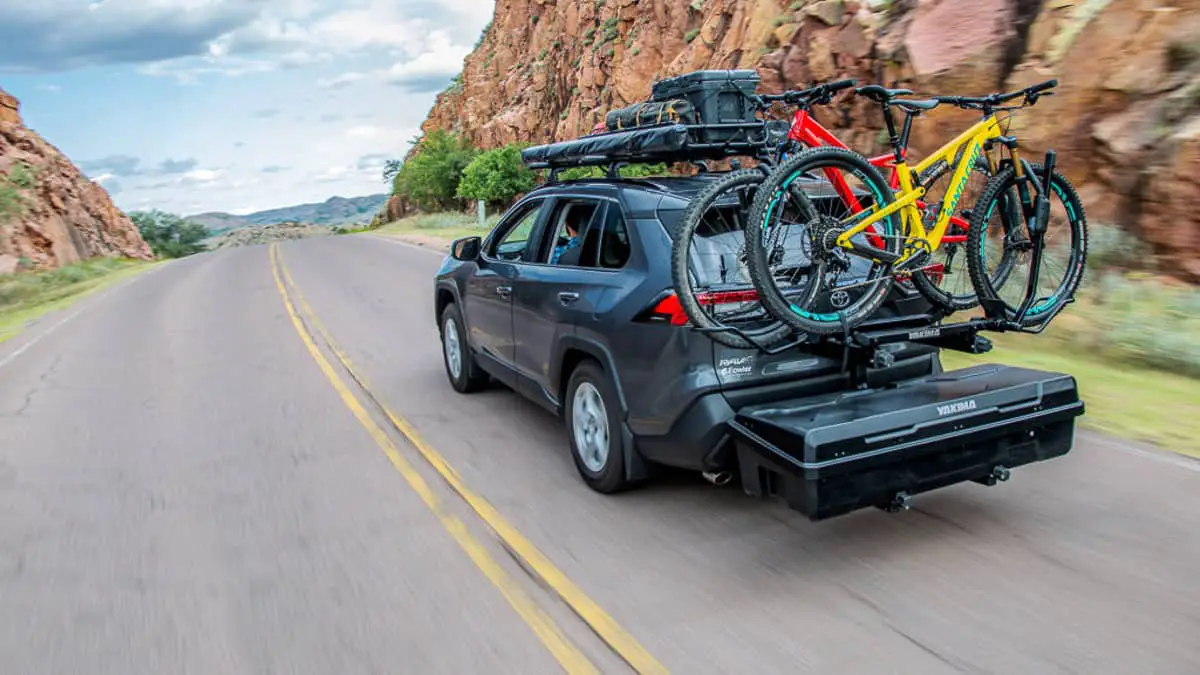Hitch cargo carriers can be handy for moving more loads than your car can carry on a regular day. They are affordable, easy to load/unload, and mostly silent throughout the journey, but what about their impact on fuel economy? Do they affect your MPG?
Hitch cargo carriers affect your MPG, but not too much. When they are empty, they have little to no effect. But with cargo, they cause more fuel burn by increasing your car’s wind drag based on how you set them. Besides, the bags are always extra weight on your auto. And more weight means less MPG.
In the rest of this article, I’ll dive deeper into these reasons while sharing some practical results. You’ll also discover ways to increase your car’s MPG with or even without the carrier.
Understanding How Hitch Cargo Carriers Affect Your MPG

For some owners, hitch cargo carriers are more than trivial car additions. They are indispensable for moving heavy camping & fishing gear, bikes, or even smaller bags that no longer fit into the trunk.
When in use for short journeys, like within the city, there’s hardly any need to worry about its fuel economy effect. However, there’s a more significant MPG drop during longer trips like inter-state travel. But why?
Most importantly, cargo carriers helping you haul more loads means extra weight for your car’s engine to pull. And from a study, an increase in a vehicle’s weight directly increases its fuel consumption for the same distance.
Every five percent increase in vehicle weight reduces its fuel economy by two percent. It is due to the greater inertia and rolling resistance that requires more engine power to move.
Moreover, setting your load on this carrier may increase your car’s aerodynamics, reducing your MPG.
With an empty carrier, air flows only through your car’s body, especially while driving on windy days. The air causes wind drag, which makes you burn more fuel than usual.
This wind drag increases with cargo like bikes that stick out sideways or above your auto from the hitch carrier. Hence, it can lessen your MPG even more.
Experiments Determining How Much Hitch Cargo Carriers Affect MPG
There’s no definite measure of how much hitch cargo carriers affect MPG. Different cars at various speeds carrying varying weight loads on several hitch carrier types will impact cars’ MPGs differently.
However, these two test results can provide an overview for your curiosity:
Department of Energy’s Test
To understand how much cargo carriers reduce vehicle fuel economy, the U.S. Department of Energy tested them on two cars – a 2009 Ford Explorer and a 2009 Toyota Corolla. The testers recorded their MPG without cargo and then with a 100 lbs (45.36 kg) load on a hitch cargo carrier.
Running at 65 miles per hour (104.6 kph) on average, both vehicles produced only a 1% decrease in fuel economy with the cargo. At increased speed, there was more loss, but still negligible.
From shared pictures, the load on the carrier didn’t alter the car’s aerodynamics. Other unknown details include the distance traveled, weather conditions, and the exact weight of the autos before including the carriers.
On a regular day, these factors will also impact your MPG for the better or, mostly, worse.
Consumer Report’s Test
More recently, experts from Consumer Reports experimented with a 2019 Toyota RAV4 small SUV and a 2019 Nissan Altima sedan. The hitch carriers were bike racks this time, tested when loaded and unloaded with bikes.
At 65 mph (104.6 kph) on average, the RAV4 SUV only lost 2% of its MPG with an empty hitch rack. When loaded with two bikes, the loss rose to 12%.
The Sedan lost much more with loaded bikes at the same average speed. When empty, there was a 3% decrease in fuel economy, which rose to 25% when loaded.
Note: An average bike can weigh 17 to 80 lbs (7.7 to 36.29 kg), depending on size and what it’s made of. So, two bikes shouldn’t weigh less than 35 lbs (15.87 kg) at least and more than 160 lbs (72.57 kg) at most.
How To Increase Your MPG With a Hitch Cargo Carrier
It’s pretty disturbing if you notice a significant drop in MPG whenever you’ve loaded your hitch cargo carrier. You need to carry the cargo, but the cost of refueling gas is another worry.
Luckily, there are some measures to take:
- Ensure your cargo fits entirely behind your car. Large loads can increase your car’s wind drag, resulting in reduced MPG. So, if you have adjustable loads on your hitch carrier, ensure they’re closest to the car and ground with no part sticking out of the vehicle, sideways or above. This region is called a slipstream. Although, this isn’t always possible, especially when the cargo is bikes. Hence, it should only matter when likely.
- Drive at a slower pace. From the Department of Energy’s discovery, driving faster exponentially decreases your MPG. So going slower is the cheapest and easiest method to improve your MPG. There are hardly any restrictions on driving slower than usual, so take this to your advantage and save some fuel today.
- Avoid windy days. If you can’t decide when to move your cargo, look up the weather forecast and avoid driving on windy days. This is especially important when your load isn’t in the vehicle’s slipstream. But even without the cargo, the wind resistance lowers fuel economy.
- Don’t take unnecessary equipment. Avoid packing cargo you aren’t sure you’ll use because of its extra weight. The weight causes a greater rolling distance and inertia, which requires more engine power, hence more gas to move.
Over 200,000 km (12,4274.24 mi), the estimated fuel cost savings on reducing a car’s weight load by 10 kg (22 lbs) is about $100. Reducing the weight by 25 kg (55 lbs) will save you over $200 and the same amount by 50 kilograms (110 lbs).
Conclusion
Hitch cargo carriers affect your MPG because of their weight and possible wind drag. The U.S. Department of Energy and Consumer Report, respectively, have proven it from various tests on a Ford Explorer, Toyota Explorer, Toyota RAV4, and Altima Sedan.
To increase your car’s MPG, drive slower, ensure the cargo is in your car’s slipstream, avoid driving on windy days, and reduce the load’s weight when possible.
Sources
- ScienceDirect: Predicting vehicle fuel consumption in energy distribution companies using ANNs
- Torque: Fuel consumption and vehicle weight
- GALE ACADEMIC ONEFILE: Accurate Fuel Economy Prediction via a Realistic Wind Averaged Drag Coefficient
- Office of Energy Efficiency & Renewable Energy: Fact #981: June 12, 2017, Using a Cargo Box on Top of a Vehicle Can Reduce Fuel Economy by 25%
- Cars.com: 2009 Ford Explorer
- Cars.com: 2009 Toyota Corolla
- Consumer Reports: How Bike Racks Affect a Car’s Fuel Economy
- Cars.com: 2019 Toyota RAV4
- Cars.com: 2019 Nissan Altima
- Wikipedia: Slipstream
- Hot cars: Here’s How Drag Coefficient Affects Fuel Economy
- Auto$mart: Learn the facts: Weight affects fuel consumption
- Suspension Traveler: How Much Bike Racks Affect Gas Mileage (Hitch vs. Roof)
- StealthGTI: Pros and Cons of Various Cargo Transport Methods
- How Do Bike Racks Affect Gas Mileage [The Answer Will Surprise You]


